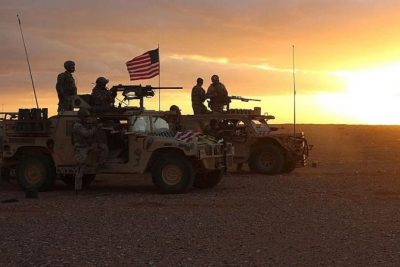What Did We Learn from Iraq War 2.0?

All Global Research articles can be read in 51 languages by activating the “Translate Website” drop down menu on the top banner of our home page (Desktop version).
To receive Global Research’s Daily Newsletter (selected articles), click here.
Visit and follow us on Instagram at @globalresearch_crg and Twitter at @crglobalization. Feel free to repost and share widely Global Research articles.
***
March 19 passed without a mention of its ghosts. The day was the 19th anniversary of Iraq War 2.0, the one about Saddam Hussein’s weapons’ of mass destruction. What have we learned over the almost two decades since?
While the actual Gotterdammerung for the new order took place just six months ago in Afghanistan, as the last American troops clambered aboard their transports, abandoning American citizens and a multi-million dollar embassy to the same fate as Saigon, Iraq is so much more the better example. The Afghan War did not begin under false pretenses as much as it began under no pretenses. Americans in 2001 would have supported carpet bombing Santa’s Workshop. Never mind we had been attacked by mostly Saudi operators, the blood letting would start in rural Afghanistan and the goal was some gumbo of revenge, stress relief, hunting down bin Laden in the wrong country, and maybe nation building, it didn’t matter.
But if Afghanistan was a pubescent teenager’s coming to the scene too quickly, Iraq was a seduction. There was no reason to invade it, so one had to be created. The Bush administration tried the generic “Saddam is pure evil” approach, a fixture of every recent American conflict. He gasses his own people (also tried later in Syria with Assad.) Saddam is looking to move on NATO ally Turkey (substitute Poland in 2022.) But none of these stuck with the American public, so a narrative was cut from whole cloth: Saddam had weapons of mass destruction, WMDs, chemical and biological, soon enough nuclear. He was a madman who Had. To. Be. Stopped.
That this was completely untrue mattered not at all. The American MSM took up the story with great energy, first as stenographers for the Bush Administration fed by public statements, and then as amplifiers of the message fed by leaks from senior officials. At the same time, dissenting voices were stifled, including a number of whistleblowers who had been working inside Iraq and knew the weapons claims were a hoax. In an age before social media, the clampdown on other ideas was near total. When their true editor-in-chief George W. Bush stood up, a mix of Ben Bradley and Lou Grant, to proclaim “you were either with us or with the terrorists,” the media stifled dissent in its ranks nearly completely.
It became obvious from the initial days of the invasion there were no WMDs, but that mattered little. The WMDs were only the excuse to start the war. Once underway, the justification changed to regime change, democratization, nation building, and then as America’s own actions spawned an indigenous terrorist movement, fighting the indigenous terrorist movement. When all that devolved into open Sunni-Shia civil was in Iraq, the justification switched to stopping the civil war we had started. It was all a farce, with the media fanning the flames, rewriting its “takes” and creating new heroes (Petraeus) to replace the old heroes they had created who had failed (all the general before Petraeus.) The NYT issued a quiet mea culpa along the way and then like a couple caught having affairs who decided to stay married anyway, vowed never to speak of this again.
That mea culpa is worth a second look in light of Ukraine 2022. The Times wrote its reporting “depended at least in part on information from a circle of Iraqi informants, defectors and exiles bent on regime change in Iraq, people whose credibility has come under increasing public debate.” In other words, sources with a goal of their own are not reliable. The Times noted that information from all sources was “insufficiently qualified or allowed to stand unchallenged. Looking back, we wish we had been more aggressive in re-examining the claims as new evidence emerged — or failed to emerge.” In other words, stenography is not good journalism. A reporter should ask questions, challenge veracity, and especially should do so as new information comes to light. The NYT also said “Articles based on dire claims tended to get prominent display, while follow-up articles that called the original ones into question were sometimes buried. In some cases, there was no follow-up at all.” The memory hole.
Those are of course Journalism 101-level errors admitted to by arguably the most prestigious newspaper in the world. It would be easier to be more generous to the NYT (and of course they are just a placeholder for all MSM who committed the same sins) if they had not gone on to purposefully repeat many of the same crimes reporting on Libya and Syria, Russiagate, the Covid crisis (“two weeks to flatten the curve”) and now, the war in Ukraine.
The big change is that while in its previous abetting of propaganda the Times, et al, took the side of the US government in supporting war, in Ukraine they are working for the Ukrainian government. Almost all of the video and imagery out of Ukraine comes from the government and those anonymous sources of 2003 have been replaced by no real sourcing at all, simply scary pictures and nameless English-speaking peasants somehow conversant in Zelensky’s own talking points.
Here’s eight seconds of a tank blowing up. Where was it shot? When? Was the explosion caused by a mine, a missile, or something internal to the tank? In most cases the media has no idea of the answers. Even if they tumble on to the basic who-what-where, the exploding tank video is devoid of context. Was that the lead tank hit, blunting the Russian advance toward a village? Or was it a Russian tank that lingered in an open field and got picked off in a lucky shot, strategically without much consequence? It is just a little jolt for the viewer. Such videos were immensely popular among terrorists in Iraq; nearly every one captured had inspirational video on his phone of a US vehicle being blown apart by a roadside IED. Now the same thing is on MSNBC for us.
Remember that stalled Russian convoy? The media stumbled on online photos of a Russian convoy some 40 miles long. Within hours those images became a story — the Russians had run out of gas just miles from Kiev, stalling their offensive. That soon led to think pieces claiming this was evidence of Russian military incompetency, corruption, and proof Ukraine would soon win. It all fit with the narrative of plucky, brave Ukrainians standing up to Putin the madman, the deranged psychopath threatening NATO and indeed democracy itself. If only the U.S. would step in an help! The whole of the American media has laid itself available to funnel the Zelensky message westward — go to war with Russia. We’re shown a photo of a destroyed building, maybe from 2016 maybe from yesterday. It soon becomes a hospital bombing by the Russians. A photo of a stationary vehicle is narrativized as the Ukrainians are capturing Russian gear. The media is once again taking whole information provided by sources with an agenda, drawing the US into this war, and reporting it uncritically and unchallenged.
Any information from the Russian side is instantly misinformation, and the pseudo-media of Twitter and Facebook not only call it fake, they make efforts to block it entirely so Americans cannot even view it long enough to make up their own minds. Pro-war journalists in America demand dissenters be investigated as foreign agents. You can’t see Facebook in Moscow and you can’t see RT in America. That’s not the equivalency a democracy should ascribe to.
As with Iraq, the goal is to present a one-sided, coordinated narrative of a complex event with the goal of dragging America into a new war. Will it work again this time?
*
Note to readers: Please click the share buttons above or below. Follow us on Instagram, @globalresearch_crg and Twitter at @crglobalization. Feel free to repost and share widely Global Research articles.
Featured image is from Al-Masdar News
The Globalization of War: America’s “Long War” against Humanity
Michel Chossudovsky
The “globalization of war” is a hegemonic project. Major military and covert intelligence operations are being undertaken simultaneously in the Middle East, Eastern Europe, sub-Saharan Africa, Central Asia and the Far East. The U.S. military agenda combines both major theater operations as well as covert actions geared towards destabilizing sovereign states.
- ISBN Number: 978-0-9737147-6-0
- Year: 2015
- Product Type: PDF File


